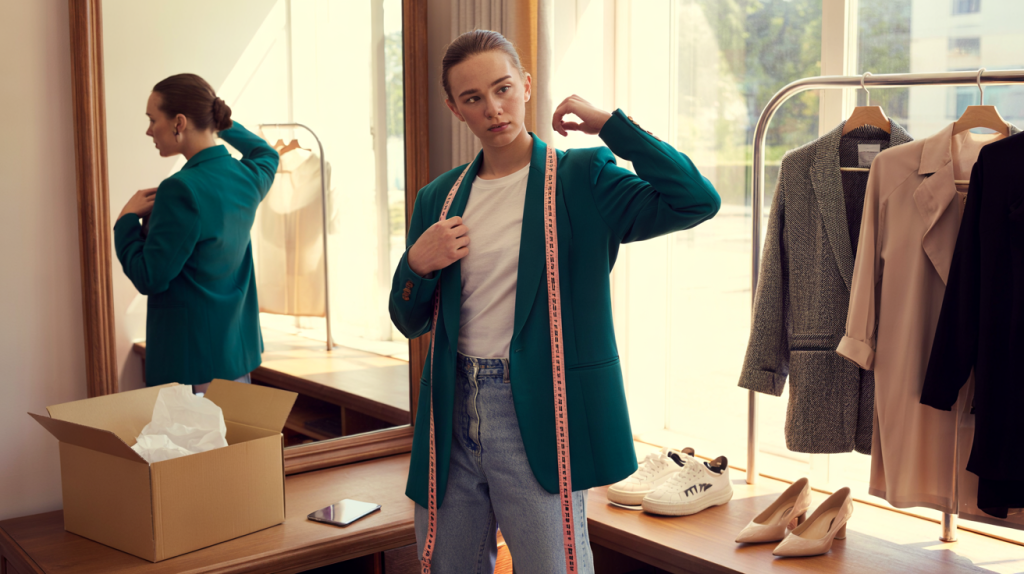Clicked on “try-on tips” for a quick win before the next shopping run. Good call. The right fitting moves turn a risky purchase into a reliable favorite, whether it happens under store lights or on a bedroom rug with the delivery box still open.
The stakes are real. Returns eat time and confidence, and they cost retailers a fortune which trickles back to shoppers. The National Retail Federation and Appriss Retail reported an overall US retail return rate of 16.5% in 2022, then 14.5% in 2023, equal to 816 billion dollars and 743 billion dollars. Fit sits at the heart of that story, especially for apparel, and small try-on habits change the outcome fast.
Clothing Try-On Tips: Start With Fit, Not Size
Size tags vary across brands and even within the same brand. Fit stays consistent when anchored to body landmarks. Start with the shoulder seam sitting right on the shoulder tip. If the seam drops onto the arm, the piece reads bigger than it seems. If it climbs toward the neck, movement will feel tight.
Check the rise on pants where the body bends when sitting. If fabric pulls at the front or the back floats away from the lower back, the rise does not match the body. That mismatch shows up later as constant adjusting.
Fabric changes the rules. A high-cotton denim relaxes after an hour. A viscose dress drapes more once heat and humidity kick in. Tweed and structured wool hold shape and can feel snug on day one without stretching. That is useful and it tells when to size up or down on the spot.
Fitting Room Strategy: Light, Movement, and Mirror Checks
Store mirrors and light can flatter, or distort. Step to a spot with daylight if possible, then take two photos from waist level, front and side. The camera catches pulling lines that eyes ignore in warm light. Quick and honest.
Do a movement trio. Sit, reach overhead, and walk ten steps. Seams that twist, waistbands that creep, hems that kick out, all reveal themselves here. A dress that passes the trio will behave in real life, not just for a still moment.
Test the hem with your real shoes. A blazer that looks sharp barefoot can collapse when paired with chunky sneakers. Clothing is a system, not a solo act, so replicate the system while trying on.
Online Try-On and Size Guides: Reduce Returns With Proof
At home, recreate store clarity. Unbox, steam or smooth creases, then try in daylight first. Keep a soft tape on hand and measure three points that never lie: shoulder width, true waist, and the best-fitting pant’s waist and hip laid flat. Compare to the product’s garment measurements if listed, not only the size chart.
Returns data reinforces the value of this prep. The National Retail Federation notes the US retail return rate eased from 16.5% in 2022 to 14.5% in 2023, a reminder that better product data and smarter customer routines make a measurable difference. Retailers publish exact garment measurements more often now, since it cuts avoidable returns that once occured silently.
When a site offers model specs and the size worn, match proportions, not just height. If the model’s shoulders are wider than yours, the drape seen on screen will not copy at home. Same logic for inseam length on trousers and the shoe heel used in photos.
Quick checklist to keep near the mirror:
- Track two reference garments that fit perfectly, and measure them flat once. Use those numbers every time.
- Check fabric composition for stretch percentage and recovery, not just the brand’s fit note.
- Order a single “control” size first when unsure, then bracket only if timelines allow easy returns.
- Photograph front, side, and back in natural light, then decide after a five-minute wear test.
- Read reviews that mention height, weight, and body shape, not only star ratings.
Tailoring, Fabric Behavior, and What Completes the Outfit
Small alterations turn a good try-on into the right garment. Hemming trousers to the shoe you actually wear anchors the silhouette. Taking in a waist by a centimeter removes pooling fabric and unlocks clean lines through the hips. These two steps solve most near-miss fits without chasing a different size.
Heat and time matter. Denim eases through the seat and knees after one hour, while tightly woven cotton poplin barely shifts. Do a short wear test at home, then sit to see where the garment settles. If comfort arrives only when a piece is visibly sagging, the base size is off and tailoring will not fix it.
Color and texture change how fit reads. Dark, matte fabrics visually slim and hide micro folds. Light, shiny weaves highlight every tension line. If stress lines appear across the chest only in glossy satin, the pattern is close, yet the fabric choice magnifies the strain. Switching fabric or easing the fit by half a size is the clean solution.
The final pass links outfit parts. A tee under a blazer alters arm mobility. A belt changes pant rise comfort. The bag’s strap can wrinkle a shoulder line on soft suiting. Build the look as it will be worn, then confirm seams still sit where they should. That last check saves exchanges and keeps the piece in rotation, not in the return box.
